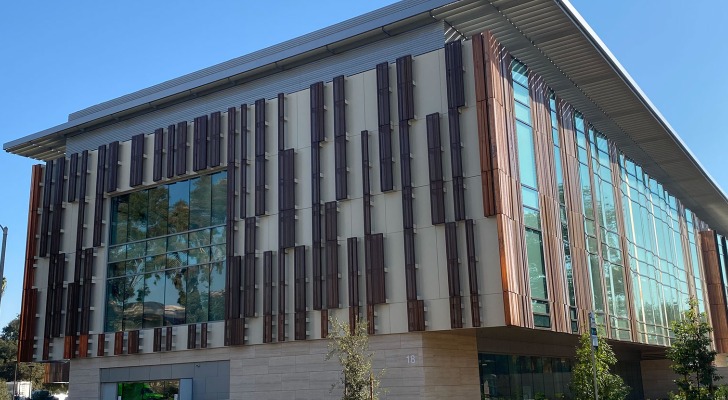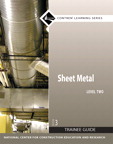Copper is having a revival in recent years in new and restored buildings, as a growing number of designers are looking toward more sustainable and timeless materials. To showcase and celebrate the best applications of copper in North America, the Copper Development Association (CDA) awarded 12 innovative copper building projects in the United States and Canada as part of its annual North American Copper in Architecture (NACIA) awards program.
The NACIA awards program, established in 2008 by CDA and the Canadian Copper & Brass Development Association (CCBDA), recognizes copper buildings in the United States and Canada selected in three categories: new construction, restoration and ornamental spplications. Winning projects represent a wide variety of design styles and buildings, including residential structures, government facilities and churches – all of which were executed with remarkable detail, creativity and craftsmanship.
“While a popular choice now, we can expect innovation and use of copper to continue to increase for building systems such as roofing and interiors, and more frequently recently for traditional and engineered cladding systems,” says Stephen Knapp, the director of the Strip, Sheet, & Plate Council for CDA. “The 2021 NACIA winners have demonstrated the continual evolution of copper in design, showcasing how the metal’s versatility and beauty meets function, while answering the growing demand to meet increasing sustainable building standards.”
New Construction
1. Tianqiao and Chrissy Chen Neuroscience Research Building

Photo by Kovach
Founded in 1891, The California Institute of Technology (Caltech) is home to world renowned researchers and Nobel Prize winners. The Chen Neuroscience Research Building is a fitting addition to the historic campus located in Pasadena, Ca. The Chen Institute’s mission is to research the human brain and explore the foundations of our humanity. The design of the Chen Building at Caltech takes inspiration from these endeavors to create flexible, fully customizable labs along with a wide range of collaboration spaces in an environment that is both organized and creative. Three natural materials - Travertine, unfinished copper, and Glass - were selected for their essential qualities to express Endurance (Stone), Change (Copper) and Vision (Glass).
- Copper Wall Cladding Manufacturer/Installer: Kovach Enclosure Systems, LLC, Chandler, Arizona
- Architect: SmithGroup, Los Angeles, California
- General Contractor, Hensel Phelps, Irvine, California
2. The Pavilion at Grace

Photo by Jeff Goldberg/ESTO
- Architect: Centerbrook Architects and Planners, Centerbrook, Connecticut
- General Contractor: Bowerman Associates, Providence, Rhode Island
- Sheet Metal Contractor: Crocker Architectural Sheet Metal Company, North Oxford, Rhode Island
3. 1701 Rhode Island Ave.

Photo by Alan Schindler
1701 Rhode Island is the renovation of a former YMCA in D.C. into a seven-story, 104,000-SF office building designed to reflect the historic character of the neighborhood with a contemporary interpretation. To pay homage to the nearby historic St. Matthew's Cathedral and its copper dome, the new building exterior features a glass and copper façade. Each of the 1,700 shingles along the six-story façade was individually patina treated by hand to exalt the copper’s natural hues and chamfered at their corners. The exterior layer is made from 100% copper sheets which allow for an authentic shingle installation method and preserve the ability to recycle the material for future use.
- General Contractor: The Whiting-Turner Contracting Company, Greenbelt, Maryland
- Structural Engineer: SK&A DC Structural Engineers, Washington, D.C.
- MEP Engineer: GHT Limited, Arlington, Virginia
- Copper Installer: The James Myers Company, Beltsville, Maryland
4. Branch House

Photo by David Hartwell
The Branch House, designed for a couple who are, both avid art collectors, is located on a one acre-lot in the hills of Montecito. The property originally held a 1960’s Ranch House that followed the standard tropes of American suburbia: a front yard dedicated to automobile and lawn, and a back yard disconnected from the house. The new house, arranged in the round, is conceived as a cluster of program volumes each with its own unique orientation to light and view. In addition to providing a primary view out to the landscape, each volume was also provided with skylights to offer a secondary natural light source and a view of the sky. An interstitial connecting-spine lined with glass was designed as the home’s main circulation spine and as a gallery to display art.
- Structural Engineer: Joseph Perazzelli Structural Engineering, Los Angeles, California
- General Contractor: RHC Construction, Santa Barbara, California
- Landscape Architect: Wade Graham Landscape Studio, LLC, Los Angeles, California
- Civil Engineer: Michael Viettone Civil Engineering, Santa Barbara, California
- Sheet Metal Contractor: Martin Roofing & Sheet Metal, Santa Barbara, California
5. Christ Chapel at Hillsdale College

The Christ Chapel is a new chapel on the grounds of Hillsdale College in Michigan built from 2017-2019. The entrance portico is formed by eight limestone columns crowned with a 32-foot self-supporting brick dome cladded in copper standing seam panels and topped with a 5-foot decorative copper pine cone finial. The copper roof panels and the ornamental pine cone finial were designed and fabricated in Toronto, Canada and shipped to the site in Michigan. The copper dome panels were laid out in a pattern consisting of 3-courses tapered pans with standing seam locks. The dome included a raised rib pans every seven tapered pans to achieve the final aesthetic and the roof's water tightness. Each panel had to be carefully laid out by hand and have a compound curve applied to fit the dome structure in Michigan. The pinecone finial is 5’x3’ foot and was made using a traditional technique called repoussé which entails hand-hammering a copper sheet into a handmade pinecone mold. This is the same technique used on the Statue of Liberty, although on a much smaller scale.
- Sheet Metal Contractor: Heather and Little Ltd., Markham, Ontario
- Architect: Duncan G. Stroik, South Bend, Indiana
- General Contractor: Weigand Construction, Fort Wayne, Indiana
- Sheet Metal Contractor: Braman Roofing Company, Hillsdale, Michigan
Restoration
6. Old City Hall

Photo by Alex Alpert
Built in 1869, this National Historic Landmark served as Boston’s City Hall until 1969. The project consisted of meticulously restoring the Dome and Mansard Levels of the building involving gutters, flat seam panels, decorative dormer and parapet duplication. The copper dome and slate mansard of the Old City Hall is a major visual landmark visible from many areas of downtown Boston.
- Sheet Metal Contractor: Gilbert & Becker Co, Dorchester, Massachusetts
- Architect: McGinley Kalsow & Associates, Somerville, Massachusetts
7. Andrew's Wesley United Church Seismic Upgrade

Photo by Michael Sherman
The St. Andrew’s-Wesley United Church was constructed between 1931 and 1933 and is a remarkable example of the Gothic Revival style in Vancouver and Western Canada. Unfortunately, long-term roof leaks were negatively impacting the interior plaster elements. This was the catalyst for the project and allowed the Church to pay an homage to its heritage through a large-scale restoration, highlighting copper as a featured element.
- Building Enclosure Engineer / Structural Engineer: RJC Engineers, Vancouver, British Columbia
- Architect: Ryder Architecture, Vancouver, British Columbia
- General Contractor: Heatherbrae Builders, Richmond, British Columbia
- Sheet Metal Contractor: TEK Roofing Ltd, Coquitlam, British Columbia
8. Andrew's Catholic Church

Photo by Jason Lee
The St. Andrew’s Catholic Church Steeple/Masonry Restoration Project took place in Roanoke, Virginia. The main goals of this project were the repair, restoration, and preservation of the historic twin steeples and the spire of the 125-year-old church. The structure includes an east and a west steeple. Each steeple consists of a square masonry tower containing a belfry, and a wood framed slate and copper covered steeple towering above the belfry. Combined, St. Andrews stands at a mighty 175 feet.
- General Contractor: The Durable Slate Company, Columbus, Ohio
- Architect: Cornett & Cundiff, Inc., Roanoke, Virginia
- Structural Engineer of Record: Master Engineers And Designers, Lynchburg, Virginia
- Sheet Metal Contractor: The Durable Slate Company, Columbus, Ohio
- Copper Fabricator: Chicago Metal Supply, Chicago, Illinois
- Copper Fabricator: Ornametals, Cullman, Alabama
9. Sun Tower Dome Envelope Seismic Stabilization

The Sun Tower is a notable landmark of 17 stories (82 m / 269 ft) capped by a Beaux-Arts dome and cupola built-in 1912. It was designed by architect William Tuff Whiteway. The building takes the form of an eight-story, L-shaped block, surmounted by a nine-story hexagonal-section tower. The tower's structure is steel, which is dominantly clad in a combination of terracotta tiles and rusticated brickwork. The tower is topped with a dome and cupola that were originally roofed with terracotta tiles that were painted at a later date to resemble patinated copper. The terracotta tiles had exceeded their practical service life, and it was time to replace the roof.
- Sheet Metal Contractor: Heather and Little Ltd., Markham, Ontario
- Architect: McGinn Engineering and Preservation ltd., Vancouver, British Columbia
- Architect: Sotirios Corp, Winnipeg, Manitoba
- General Contractor: Alpha Masonry, Winnipeg, Manitoba
10. 581 Boylston Street

Photo by Matthew Wessling
This project included replacement of the decorative copper parapet at 581 Boylston Street after significant water infiltration and failure of the existing substructure. The existing copper was removed and duplicated to match the existing. The existing wooden interior framework was replaced with a combination of steel and wood. The 5 urns were removed from the site, media blasted to remove the patina and shop repaired to fix years of deterioration. The reconstructed parapet overlooks the finish line of the Boston Marathon.
- Sheet Metal Contractor: Gilbert & Becker Co, Dorchester, Massachusetts
Ornamental
11. The Fitzroy

The Fitzroy is a residential building designed by Roman and Williams. Facing north and seated very near the highline, the 10-story building springs forth from the earth on 24th St between 10th and 11th Avenues. The language of the building at first impression is likely best labeled Art Deco. Clad in highly articulate dark green terracotta ornament with a copper storefront, the façade of the Fitzroy is designed in a traditional manner – with a base, body and head. The head emerges at the setback, forming into a buttressed dormer and terraces, and is then crowned with a fluted band of brass, terracotta, and bronze. Art Deco, the last familiar and labeled ornamental and decorative movement in architecture, ended abruptly in 1939 with a fascination with abstraction and simplification. Roman and Williams chose to design the building in the continued, raw, undistilled, and dramatic spirit of that era – as if that approach to architecture had not abruptly ended, and an artistic and expressive approach to architecture was still continued and expected.
- Architectural Designer: Roman and Williams, New York, New York
12. Brighton Municipal Court

Brighton Division of Boston Municipal Courthouse was designed and built between the 1880s and 1920s. The building takes the form of a three-wing "Y" shape, and the statehouse's front entrance is composed of three-sets of twelve feet high doors cladded in bronze. The original bronze-clad doors that were installed around 1880 have deteriorated, and a necessary restoration venture was announced.
- Sheet Metal Contractor: Heather and Little Ltd., Markham, Ontario
- Architect: Simpson Gumpertz & Heger, Waltham, Massachusetts
- General Contractor: TRAC Builders, Inc., Providence, Rhode Island











